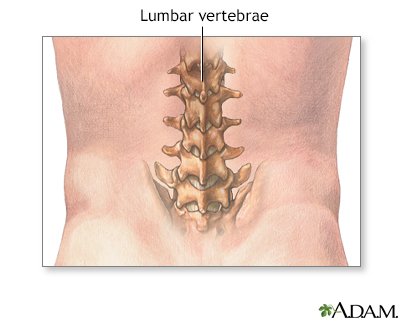Pregnancy SmartSiteTM
Spinal tap; Ventricular puncture; Lumbar puncture; Cisternal puncture; Cerebrospinal fluid culture DefinitionCerebrospinal fluid (CSF) collection is a test to look at the fluid that surrounds the brain and spinal cord. CSF acts as a cushion, protecting the brain and spine from injury. The fluid is normally clear. It has the same consistency as water. The test is also used to measure pressure in the spinal fluid. How the Test is PerformedThere are different ways to get a sample of CSF. Lumbar puncture (spinal tap) is the most common method. To have the test:
In some cases, special x-rays are used to help guide the needle into position. This is called fluoroscopy. Lumbar puncture with fluid collection may also be part of other procedures such as an x-ray or CT scan after dye has been inserted into the CSF. Rarely, other methods of CSF collection may be used.
CSF may also be collected from a tube that is already placed in the fluid, such as a shunt or a ventricular drain. How to Prepare for the TestYou will need to give the health care team your consent before the test. Tell your provider if you are on any aspirin or any other blood-thinning medicines. After the procedure, you should plan to rest for several hours, even if you feel fine. This is to prevent fluid from leaking around the site of the puncture. You will not need to lie flat on your back the entire time. If you develop a headache, it may be helpful to drink caffeinated beverages such as coffee, tea or soda. How the Test will FeelIt may be uncomfortable to stay in position for the test. Staying still is important because movement may lead to injury of the spinal cord. You may be told to straighten your position slightly after the needle is in place. This is to help measure the CSF pressure. The anesthetic will sting or burn when first injected. There will be a hard pressure sensation when the needle is inserted. Often, there is some brief discomfort when the needle goes through the tissue surrounding the spinal cord. This pain should stop in a few seconds. In most cases, the procedure takes about 30 minutes. The actual pressure measurements and CSF collection only take a few minutes. Why the Test is PerformedThis test is done to measure pressures within the CSF and to collect a sample of the fluid for further testing. CSF analysis can be used to diagnose certain neurologic disorders. These may include infections (such as meningitis) and brain or spinal cord damage. A spinal tap may also be done to establish the diagnosis of normal pressure hydrocephalus or bleeding into the spinal fluid from an aneurysm. Normal ResultsNormal values typically range as follows:
Normal value ranges may vary slightly among different laboratories. Talk to your provider about the meaning of your specific test results. The examples above show the common measurements for results for these tests. Some laboratories use different measurements or may test different specimens. What Abnormal Results MeanIf the CSF looks cloudy, it could mean there is an infection or a buildup of white blood cells or protein. If the CSF looks bloody or red, it may be a sign of bleeding or spinal cord obstruction. If it is brown, orange, or yellow, it may be a sign of increased CSF protein or previous bleeding (more than 3 days ago). There may be blood in the sample that came from the spinal tap itself. This makes it harder to interpret the test results. CSF PRESSURE
CSF PROTEIN
CSF GLUCOSE
BLOOD CELLS IN CSF
OTHER CSF RESULTS
Additional conditions under which the test may be performed:
RisksRisks of lumbar puncture include:
Brain herniation may occur if this test is done on a person with a mass in the brain (such as a tumor or abscess). This can result in brain damage or death. This test is not done if an exam or test reveals signs of a brain mass. Damage to the nerves in the spinal cord may occur, particularly if the person moves during the test. Cisternal puncture or ventricular puncture carries additional risks of brain or spinal cord damage and bleeding within the brain. ConsiderationsThis test is more dangerous for people with:
ReferencesDeluca GC, Griggs RC. Approach to the patient with neurologic disease. In: Goldman L, Schafer AI, eds. Goldman-Cecil Medicine. 26th ed. Philadelphia, PA: Elsevier; 2020:chap 368. Euerle BD. Spinal puncture and cerebrospinal fluid examination. In: Roberts JR, Custalow CB, Thomsen TW, eds. Roberts and Hedges' Clinical Procedures in Emergency Medicine and Acute Care. 7th ed. Philadelphia, PA: Elsevier; 2019:chap 60. Rosenberg GA. Brain edema and disorders of cerebrospinal fluid circulation. In: Jankovic J, Mazziotta JC, Pomeroy SL, Newman NJ, eds. Bradley and Daroff's Neurology in Clinical Practice. 8th ed. Philadelphia, PA: Elsevier; 2022:chap 88. | |
| |
Review Date: 4/29/2023 Reviewed By: Joseph V. Campellone, MD, Department of Neurology, Cooper Medical School of Rowan University, Camden, NJ. Review provided by VeriMed Healthcare Network. Also reviewed by David C. Dugdale, MD, Medical Director, Brenda Conaway, Editorial Director, and the A.D.A.M. Editorial team. The information provided herein should not be used during any medical emergency or for the diagnosis or treatment of any medical condition. A licensed medical professional should be consulted for diagnosis and treatment of any and all medical conditions. Links to other sites are provided for information only -- they do not constitute endorsements of those other sites. No warranty of any kind, either expressed or implied, is made as to the accuracy, reliability, timeliness, or correctness of any translations made by a third-party service of the information provided herein into any other language. © 1997- A.D.A.M., a business unit of Ebix, Inc. Any duplication or distribution of the information contained herein is strictly prohibited. | |

 Lumbar puncture (s...
Lumbar puncture (s... CSF chemistry
CSF chemistry Lumbar vertebrae
Lumbar vertebrae
